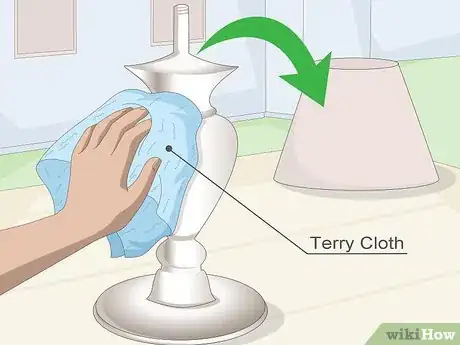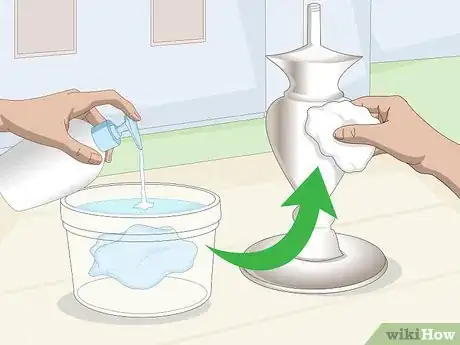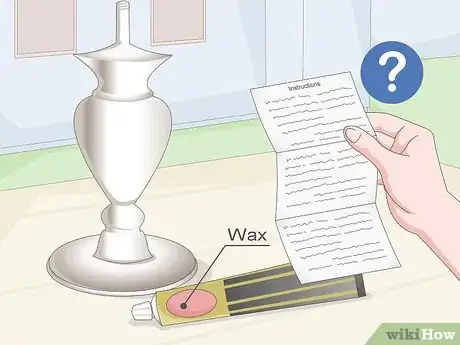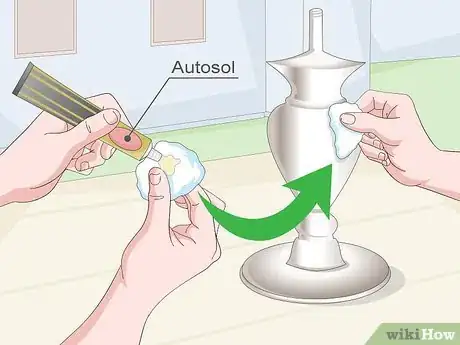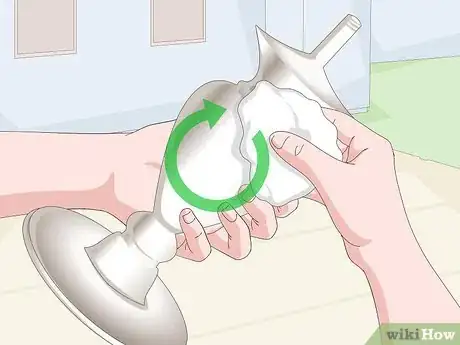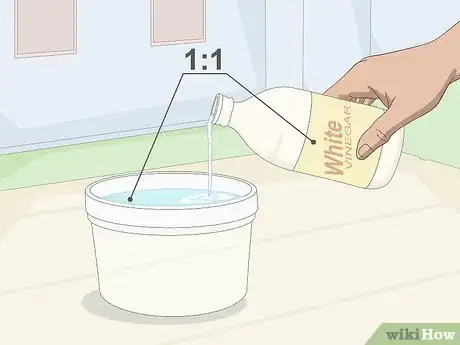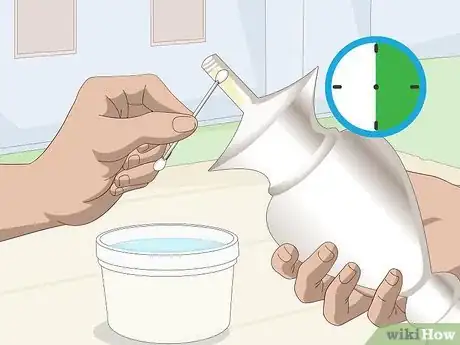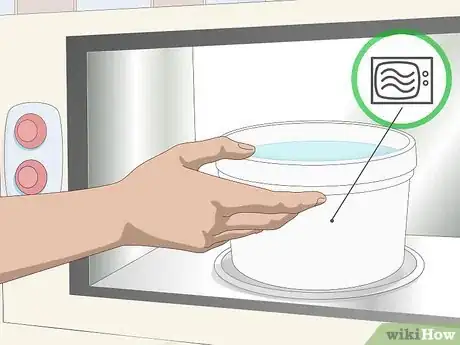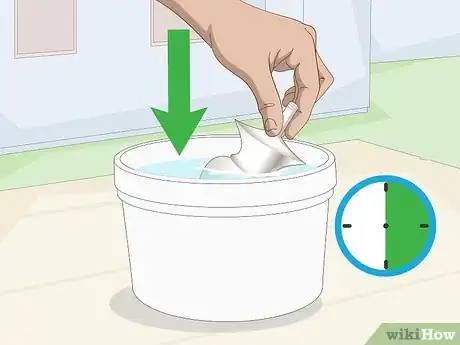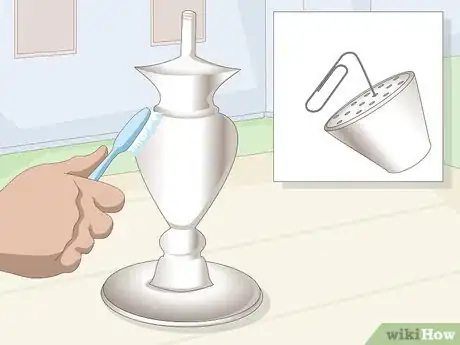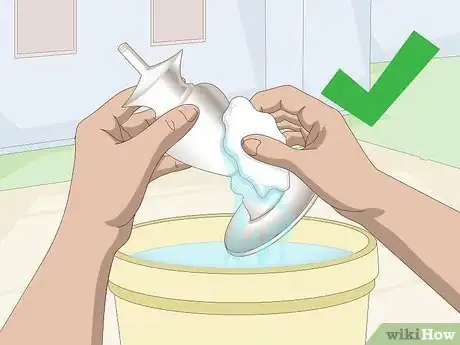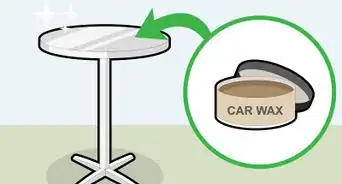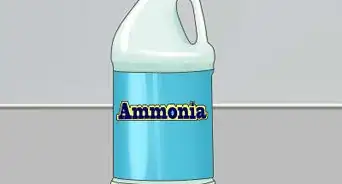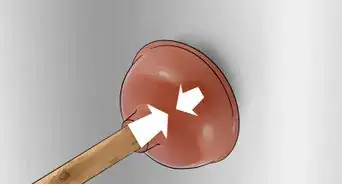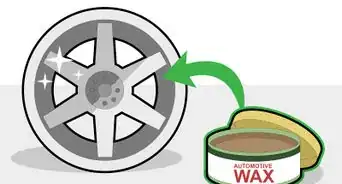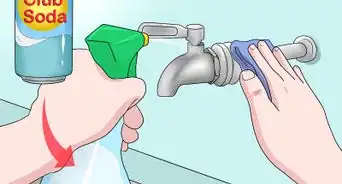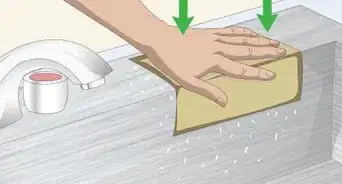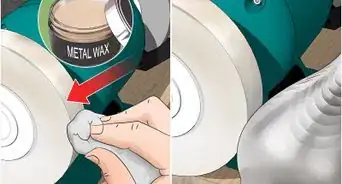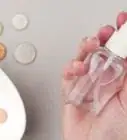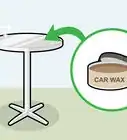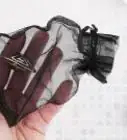This article was co-authored by wikiHow Staff. Our trained team of editors and researchers validate articles for accuracy and comprehensiveness. wikiHow's Content Management Team carefully monitors the work from our editorial staff to ensure that each article is backed by trusted research and meets our high quality standards.
This article has been viewed 247,217 times.
Learn more...
The finish used on brushed nickel is sensitive and can make cleaning somewhat difficult. When cleaning brushed nickel, you should use the gentlest method possible. Don’t use abrasive, alcohol-based, acid or solvent-based cleaners on brushed nickel. These cleaners can damage the finish. Although vinegar does contain acid, you can dilute it for use on stubborn mineral deposits if other methods haven’t worked. Do this carefully and by testing an inconspicuous area first.
Steps
Using Wet and Dry Cloths
-
1Wipe with a soft, dry cloth. Find a clean, soft, lint-free cloth. Terry cloth works well, but any soft cotton blend can prove equally useful. Remove dust, smudges, and grease. Use small, circular motions.[1]
- If you’re cleaning a light shade, remove the shade before cleaning it.
-
2Break up grime with a damp cloth and putty knife. Wet a cloth with warm water. Press the cloth onto the area with buildup. Use a putty knife to gently and carefully scrape the gunk only (not the nickel itself). Buff the area with a soft, dry cloth.[2]Advertisement
-
3Use a mild soap solution. Soak a soft, clean cloth in warm water with a squirt of detergent. Wipe your nickel item with the wet cloth. Rinse or sponge it clean with water. Dry it thoroughly.[3]
- Dishwashing soap is effective because it cuts away grease while remaining fairly gentle.
- The simpler the soap, the better. Scented soaps often contain additives that only create further streaking rather than removing it.
Polishing Brushed Nickel
-
1Determine whether wax is compatible with your product. Check the product’s instruction manual, if you still have it. Alternately, visit the brand’s website and look at the FAQ section or specific product manual. Try calling the company’s customer service number if you still can’t determine your product’s compatibility with wax.
- Some brands recommend using wax paste to polish their brushed nickel products. However, others advise against it.
- Polishing brushed nickel helps to restore its sheen.
-
2Apply wax paste. Try a very light polish using Autosol. Spread a thin layer of wax over your brushed nickel item. Allow it to sit for a few minutes.[4]
- You can find this type of polish at hardware or automotive stores.
-
3Buff the wax off. Remove the wax with a soft, clean cloth. Use circular motions to buff your product clean. Move to a new area of the cloth, as needed, so that you don’t leave wax residue on the nickel.[5]
Using Diluted Vinegar
-
1Dilute white vinegar with water. Create a solution made with half water, half white vinegar. If your item is detachable, such as a shower head, make enough solution to completely soak the item. Use a container that will fit in the microwave to save time.[6]
-
2Test a concealed area. Stir the solution well. Dip a cotton swab into the solution. Apply the cotton swab to a hard-to-see area of your nickel product. Let it sit for 30 minutes.[7]
- If no visible damage occurred to your brushed nickel finish, you can proceed to cleaning the entire item with the vinegar solution.
-
3Warm up the vinegar solution. Heat the solution in a microwave, using a microwave-safe container. Alternately, you can heat the solution in a large saucepan on the stovetop. Heat the solution only until it’s warm, not hot or boiling.[8]
-
4Spray or soak your item. If the nickel piece is small enough, dunk it directly into the solution and allow it to sit for 30 minutes. If the nickel piece cannot be removed or is too large, pour the solution into a spray bottle and douse the brushed nickel with it. Allow the solution to sit on the surface of the metal for 30 minutes.[9]
-
5Wipe away the mineral deposits. Remove the item from the solution, if applicable. Try wiping the mineral deposits off with a rag. If that doesn’t work, use soaked cotton wool or a toothbrush to clean the deposits.[10]
- If your item is a shower nozzle, use a paperclip to unclog the jet holes.
- If there are still mineral deposits remaining, repeat the diluted vinegar application once more.[11]
-
6Rinse your item clean. Don’t leave vinegar sitting on the product’s surface. Use a bucket of water or a rag wet with water to thoroughly rinse the brushed nickel. Buff dry with a soft cloth to avoid water stains.
Community Q&A
-
QuestionHow can I remove hard water stains?
 Community AnswerUse a diluted vinegar solution. Mix half white vinegar and half water. Rub the solution on in circular motions with a rag or toothbrush. Once finished, rinse and buff dry.
Community AnswerUse a diluted vinegar solution. Mix half white vinegar and half water. Rub the solution on in circular motions with a rag or toothbrush. Once finished, rinse and buff dry. -
QuestionHow do I remove stains from brushed nickel?
 Community AnswerRinse your item clean. Don't leave vinegar sitting on the product's surface. Use a bucket of water or a rag wet with water to thoroughly rinse the brushed nickel. Buff dry with a soft cloth to avoid water stains.
Community AnswerRinse your item clean. Don't leave vinegar sitting on the product's surface. Use a bucket of water or a rag wet with water to thoroughly rinse the brushed nickel. Buff dry with a soft cloth to avoid water stains. -
QuestionHow can I clean spots on a tarnished, brushed nickel mirror frame?
 Community AnswerUse a soft cloth, wet or dry, and some elbow grease. If that doesn't work, use a 50/50 vinegar and water mixture. Wipe down the frame with the solution using cotton wool or a toothbrush. Rinse the frame clean and buff dry.
Community AnswerUse a soft cloth, wet or dry, and some elbow grease. If that doesn't work, use a 50/50 vinegar and water mixture. Wipe down the frame with the solution using cotton wool or a toothbrush. Rinse the frame clean and buff dry.
Warnings
- Never use sandpaper on brushed nickel.⧼thumbs_response⧽
- Turn off the lights and circuit breaker before cleaning light fixtures. Don’t allow water to come in contact with any electrical components.[12]⧼thumbs_response⧽
- Don’t use steel wool or scratch-pad sponges on brushed nickel.⧼thumbs_response⧽
- Don’t use bleach, oven cleaner, rust cleaner or toilet cleaner on your brushed nickel.[13]⧼thumbs_response⧽
- Avoid harsh chemicals. As a general rule, anything that requires you to don protective gear is probably too harsh to use on brushed nickel. Oven cleaners and most ammonia-based cleaners are too abrasive and could cause the finishing to wear off right alongside the grime or rust.⧼thumbs_response⧽
- Be wary of warranty. Many surfaces made from brushed metal, like bathroom faucets, come with a warranty that could be voided if you use abrasive methods to clean them.⧼thumbs_response⧽
Things You’ll Need
- Soft cloths
- Putty knife
- Mild detergent
- Water
- Microwave-safe bowl or saucepan
- Wax paste
- White vinegar
- Cotton swab
- Bucket or spray bottle
- Paper clip
- Cotton wool or toothbrush
References
- ↑ http://www.ebay.com/gds/How-to-Clean-Polished-Nickel-Light-Fixtures-/10000000207036682/g.html
- ↑ http://www.ebay.com/gds/How-to-Clean-Polished-Nickel-Light-Fixtures-/10000000207036682/g.html
- ↑ http://www.hermanmiller.com/content/dam/hermanmiller/documents/materials/reference_info/nelson_bubble_lamps_care_and_maintenance.pdf
- ↑ http://www.ebay.com/gds/How-to-Clean-Polished-Nickel-Light-Fixtures-/10000000207036682/g.html
- ↑ http://www.ebay.com/gds/How-to-Clean-Polished-Nickel-Light-Fixtures-/10000000207036682/g.html
- ↑ http://www.abodedesigns.co.uk/support/product-care/kitchen-bathroom
- ↑ https://www.plumbingsupply.com/how-to-clean-a-showerhead.html
- ↑ https://www.plumbingsupply.com/how-to-clean-a-showerhead.html
- ↑ https://www.plumbingsupply.com/how-to-clean-a-showerhead.html
- ↑ http://www.abodedesigns.co.uk/support/product-care/kitchen-bathroom
- ↑ http://www.abodedesigns.co.uk/support/product-care/kitchen-bathroom
- ↑ http://www.ebay.com/gds/How-to-Clean-Polished-Nickel-Light-Fixtures-/10000000207036682/g.html
- ↑ http://www.abodedesigns.co.uk/support/product-care/kitchen-bathroom
About This Article
You can clean brushed nickel using a soft, lint-free cloth. Avoid using chemicals or abrasive cleaners on your nickel since it could damage it. Wet your cloth with water and gently wipe down the nickel. If the nickel is particularly dirty, add a bit of dish soap to the cloth. For stubborn grime, try using a putty knife to scrape it off. To learn how to polish brushed nickel, keep reading!
